Never Doubt a Viscount
The Vyne
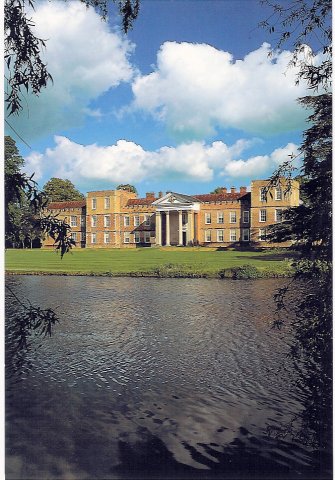
Trentingham Manorfrom across the river. Note the classical portico that was added in the 17th Century.
Trentingham Manor was inspired by The Vyne, a National Trust property in Hampshire (which I relocated to sit on the banks of the Thames). Built in the early 16th century for Lord Sandys, Henry VIII's Lord Chamberlain, the house acquired a classical portico in the mid–17th century (the first of its kind in England) and contains a grand Palladian staircase, a wealth of old paneling and fine furniture, and a fascinating Tudor chapel with Renaissance glass. The Vyne and its extensive gardens are also open for visits April through October.
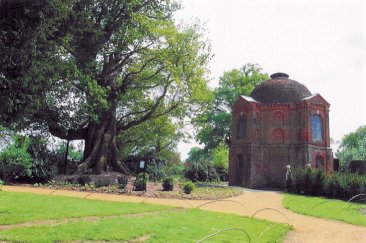 The summerhouse beside the
The summerhouse beside the twenty-guinea oak.
Snowshill Manor
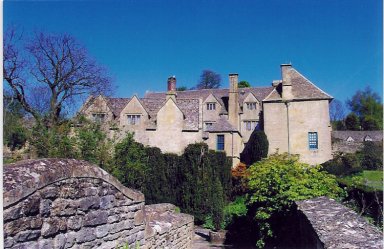
Though I moved it to the Thames, Lakefield House was loosely modeled on Snowshill Manor in Gloucestershire. Snowshill was owned by Winchcombe Abbey from the year 821 until the reign of Henry VIII in the 16th century, when, with the dissolution of the monasteries, it passed to the Crown. Thereafter it had many owners and tenants until 1919, when a man named Charles Paget Wade returned from the First World War and found it for sale. The house was derelict, the garden an overgrown jumble of weeds, including—of course!—a sundial.
 A bedroom in Snowshill. (My model for Ford's bedroom pre-renovations.)
A bedroom in Snowshill. (My model for Ford's bedroom pre-renovations.)
Wade bought Snowshill and restored it, removing the plaster ceilings, moving partitions back to their original places, unblocking fireplaces, and fitting Tudor paneling to many of the rooms to recapture the original atmosphere. He scorned the use of electricity and modern conveniences, so the house appears today much as it would have during Ford's time. Wade never lived in the house, instead using it to showcase his amazing collection of everyday and curious objects, literally thousands of items including musical instruments, clocks, toys, bicycles, weavers' and spinners' tools, and Japanese armor. The home is now owned by the National Trust and open April through October to view the house and collection.
More pictures of Snowshill Manor
Gresham College
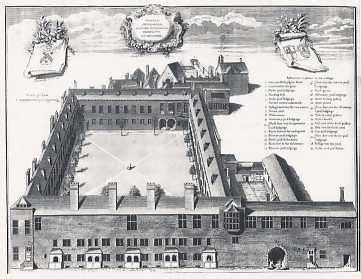 Engraving by George Vertue of Gresham College, looking east, showing the
entrance in Old Broad Street, from John Ward's Lives of the
Professors of Gresham College (1740).
Engraving by George Vertue of Gresham College, looking east, showing the
entrance in Old Broad Street, from John Ward's Lives of the
Professors of Gresham College (1740).
For over 400 years, with only a brief interruption during World War II, there has been a continuous succession of Gresham Professors giving free public lectures in the City of London. The College is named after Sir Thomas Gresham, who built the Royal Exchange (which was essentially London's first shopping mall, built in 1566).
Sir Thomas's fine mansion in Bishopsgate was the first home of Gresham College, still the college's location at the time of Never Doubt a Viscount. It was there that the Professors gave their lectures until 1768, their salaries being met from rental income from the shops around the Royal Exchange which Sir Thomas had bequeathed. The Professors, one each in Astronomy, divinity, Geometry, Law, Music, Physic, and Rhetoric, were all required to be bachelors, and they lived at Gresham College.
This period saw the formation of the Royal Society of London for Improving Natural Knowledge, chartered by King Charles II in 1662. The first two books it published were John Evelyn's Sylva, and Micrographia by Robert Hooke. With the exception of a few years following the Great Fire of London, the Royal Society met at Gresham College until 1710, when it acquired its own home.
Although Gresham's original building is gone, the College still operates
today in new quarters, offering free public lectures, seminars and
conferences. Today's Gresham Professors seek to reinterpret the
new learning
of Sir Thomas Gresham's time in contemporary terms.
For more information, visit Gresham College's website and the Royal Society's website.
Amberley Castle
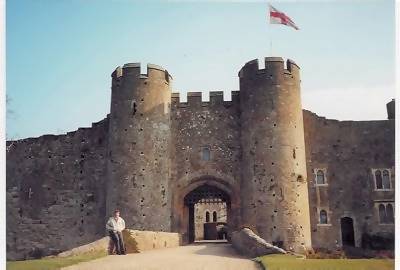 Portcullis Gate at entrance to Amberley Castle.
Portcullis Gate at entrance to Amberley Castle.
Greystone was inspired by Amberley Castle, also in West Sussex. Charles II visited the castle in 1651 and 1685. The then tenant, Sir John Brisco, commemorated the second visit by commissioning a mural of Charles and Queen Catharine, which can still be seen in the Queen's Room, now a gourmet restaurant. The castle has passed through many hands and is now run as a Country House Hotel. The walls exude the spirit of dreams and legends, and a stay there is the stuff memories are made of, well worth the splurge.
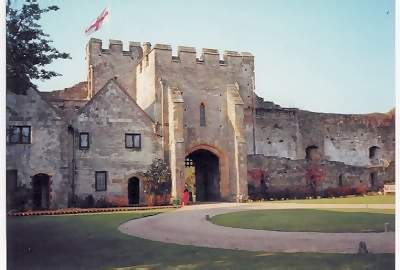 Lower Court, within the castle walls.
Lower Court, within the castle walls.









